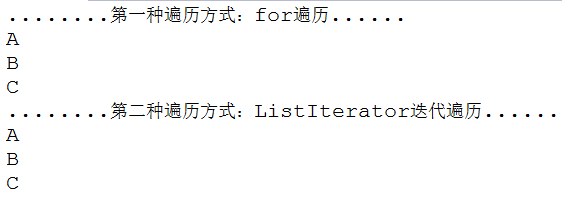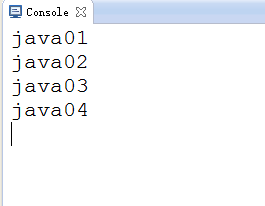
1. First of all, the List
① Collection (the collection framework appeared in JDK1.2 version)
② list: It is ordered, and the elements can be repeated, so the collection system has an index.
Often used are the ArrayList and LinkedList classes that implement this interface
③ Arraylist: The underlying data structure uses an array structure,
Features: Query speed is very fast , but additions and deletions are slightly slower. Threads are not synchronized
LinkedList: The bottom layer uses a linked list data structure.
Features: The addition and deletion speed is very fast, and the query is slightly slower.
Vector: (Appeared in JDK1.0 version) The bottom layer is an array data structure and thread synchronization. Replaced by ArrayList. (No longer used)
2. Two traversal methods for List:
public class Demo { public static void main(String[] args) { ArrayList list = new ArrayList(); list.add("A"); list.add("B"); list.add("C"); System.out.println("........第一种遍历方式:for遍历......"); for (Object li : list) { System.out.println(li); } System.out.println("........第二种遍历方式:ListIterator迭代遍历......"); ListIterator it = list.listIterator(); while (it.hasNext()) { Object obj = it.next(); System.out.println(obj); } } }
Rendering:

3. Use LinkList to simulate a stack or queue data structure. That is: Stack: first in, last out; Queue: first in, first out
class Duilie{ private LinkedList
Rendering:

The above is first in, first out. If you want to change it to first in, last out, just change it according to what is written in the code.
The above is the entire content of this article. I hope you all like it.
For more detailed explanations of List collections and their traversal in Java, please pay attention to the PHP Chinese website!
 The difference between JD.com's self-operated and official flagship stores
The difference between JD.com's self-operated and official flagship stores html set font color size
html set font color size How to set the computer to automatically connect to WiFi
How to set the computer to automatically connect to WiFi How clearfix implements clearing floats
How clearfix implements clearing floats The difference between php and js
The difference between php and js MySQL's storage engine for modifying data tables
MySQL's storage engine for modifying data tables How to center div in css
How to center div in css How to implement line break in alert
How to implement line break in alert



